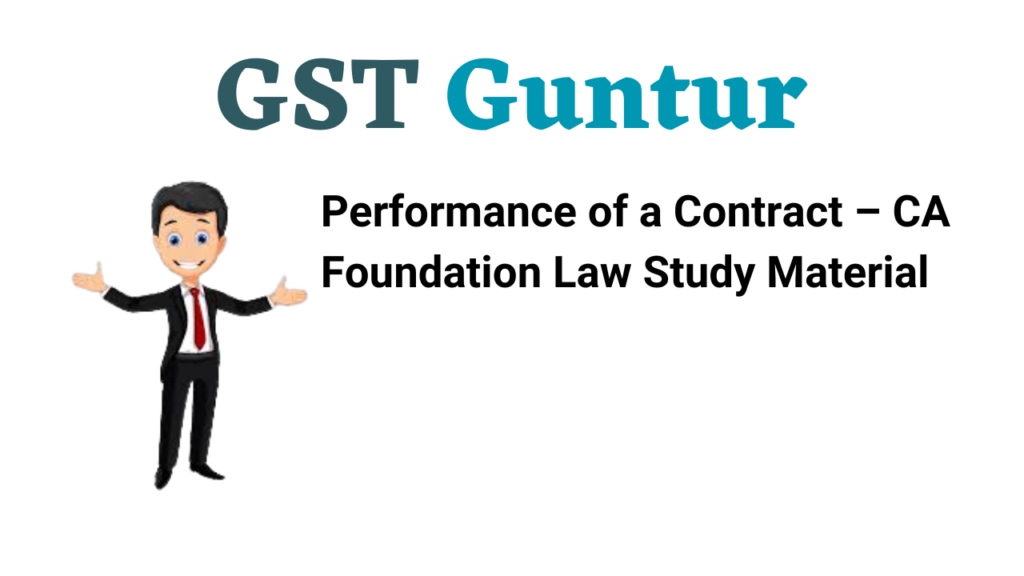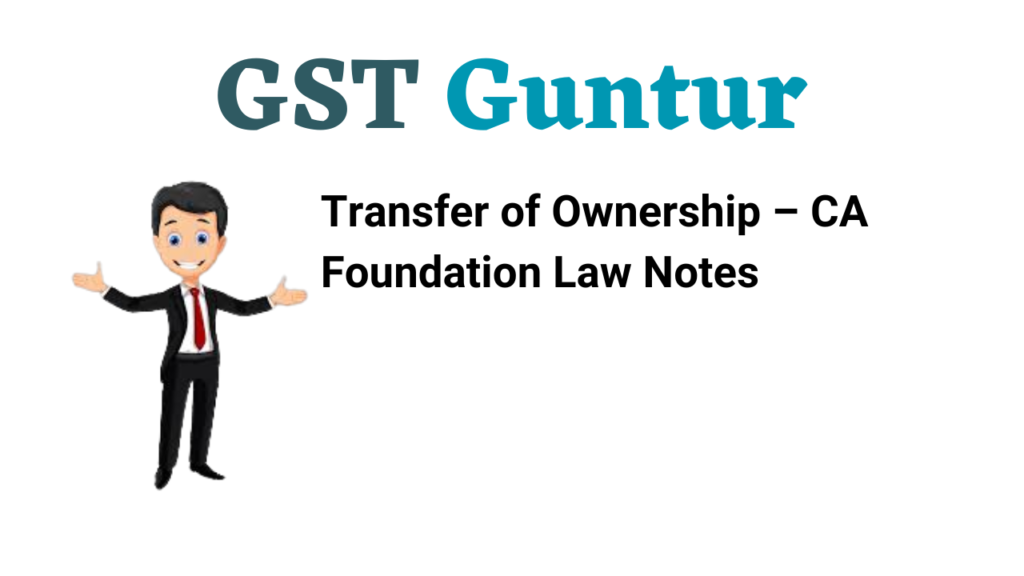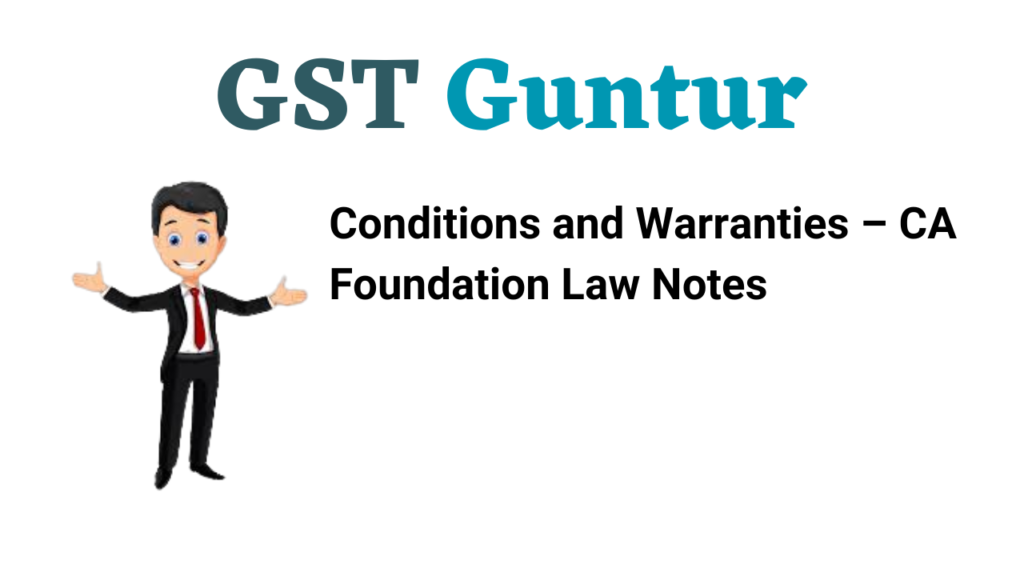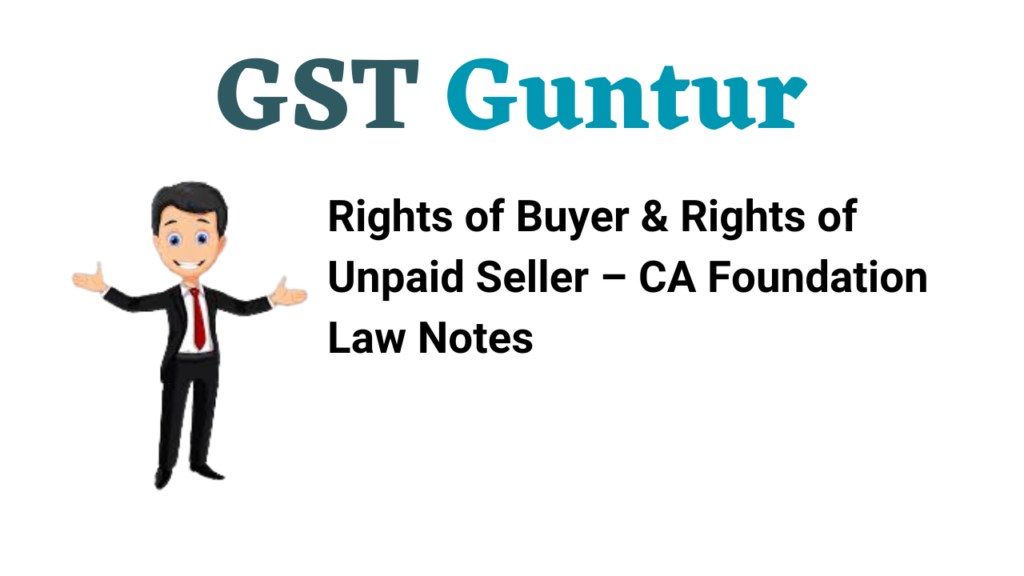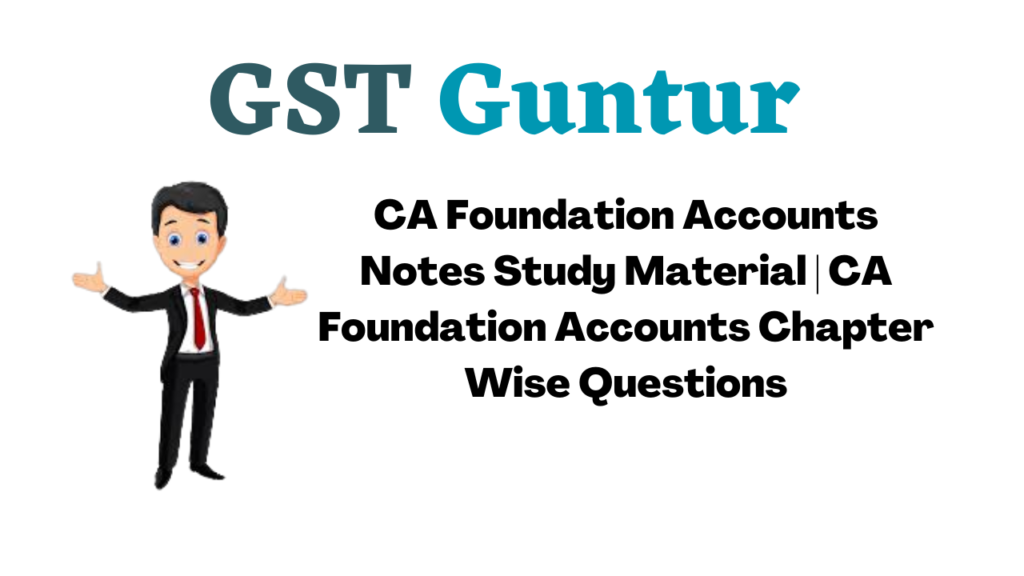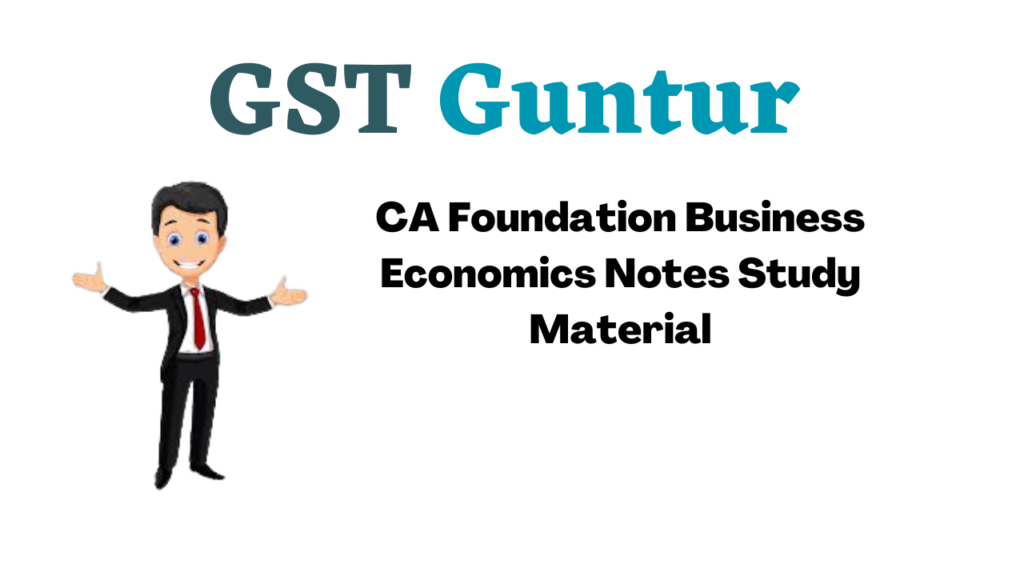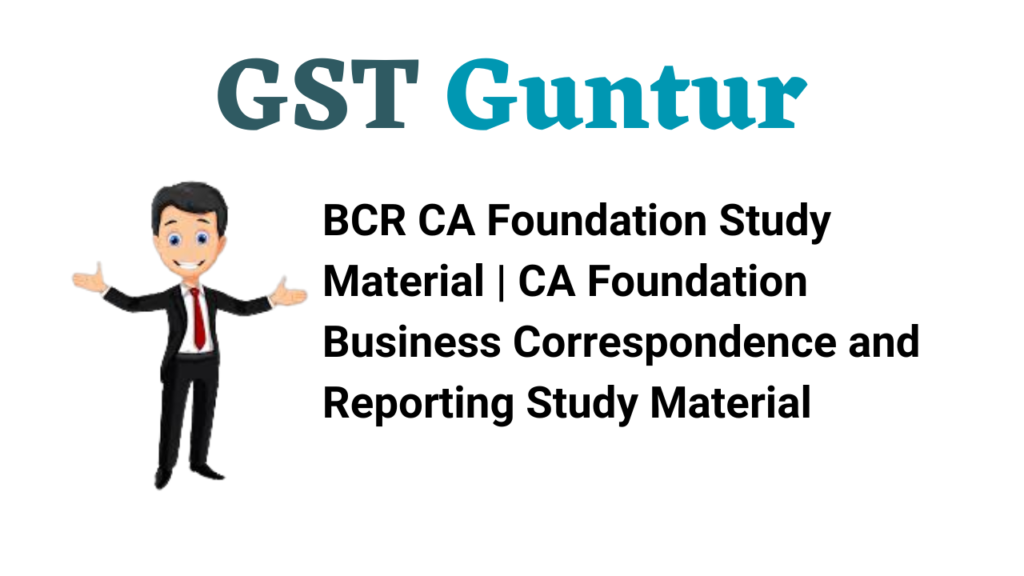Performance of a Contract – CA Foundation Law Study Material
This Performance of a Contract – CA Foundation Law Study Material is designed strictly as per the latest syllabus and exam pattern.
Performance of a Contract – CA Foundation Business Law Study Material
Question 1.
What is meant by tender of performance? What are the essentials of valid tender of performance? What is the effect of refusal by the promisee to accept a valid tender of performance in respect of goods and money?
Answer:
Attempted Performance or Tender / When the promisor offers to perform his obligation under the contract but is unable to do so because the promisee does not accept the performance, it is called “attempted performance” or “tender”. Thus, “tender” is not actual performance but is only an “offer to perform” the obligation under the contract. A valid tender of performance is equivalent to performance.
ESSENTIALS OF A VALID TENDER:
A valid tender or offer of performance must fulfil the following conditions: (Sec. 38)
- It must be unconditional (a tender is conditional where it is not in accordance with the term of the contract)
- It must be made at the proper time and place.
- It must be of the whole obligation contracted for and not only of the part.
- If the offer/tender relates to the delivery of goods, it must give a reasonable opportunity to the promisee for inspection of goods so that he may be sure that the goods tendered are of contract description.
- It must be made by a person who is in a position and is willing to perform the promise.
- It must be made to the proper person ie.t the promisee or his duly authorised agent. A tender made to a stranger is invalid.
- If there are several joint promises, an offer to any one of them is a valid tender.
- In the case of tender of money, the exact amount should be tendered in the legal tender money.
Effect of refusal to accept a properly made offer of performance or tender (Sec. 38) :
Where the promisor has made an offer of performance to the promisee, and the offer has not been accepted, then, according to Sec.38, the promisor’s obligations under the contract come to an end but his rights continue. He need not perform his part of the contract but may initiate action against the promisee for breach of contract.
Exception: If a debtor has properly offered to pay money, and the creditor refuses to accept payment, the debtor’s liability to pay shall not come to an end. However, he will not be liable to pay interest on the due amount, from the date of rejection of the tender.
![]()
Question 2.
When is the time deemed to be of the essence of a contract in the performance of a contract? What are the consequences when the party fails to perform the contract within the time stipulated in the contract?
Answer:
The phrase “ time as the essence of the contract” means that Perl romance within time is the most vital condition of the contract. If time is the essence of the contract then the other party can avoid the contract and if it is not, the other party cannot avoid the contract.
When is the time the essence of the contract?
1. Whether time is of the essence of the contract, depends upon
- The intention of the parties
- Nature of the transaction
- The terms of the contract re. if the parties to the contract have expressly agreed that performance within a limited time was necessary;
2. It is well settled that unless a different intention appears from the terms of the contract, ordinarily in commercial contracts the time of delivery of goods is of the essence of the contract but not the time of payment of the price;
3. In contracts for the purchase of land, usually time is not of the essence of the contract because land values do not frequently fluctuate.
Effects of failure to perform a contract within the stipulated time. Sec. 55 deals with the subject and lays down the following rules:
1. Where “time is of the essence of the contract” and there is failure to perform within the fixed time, the contract (or so much of it as remains unperformed) becomes voidable at the option of the promisee. He may rescind the contract and sue for the breach.
2. Where “time is not of the essence of the contract”, failure to perform within the specified time does not make the contract voidable. It means that in such a case the promisee cannot rescind the contract and he will have to accept the delayed performance. But he would be entitled to claim compensation from the promisor for any loss caused to him by the delay. This rule is, however, subject to the condition that the promisor should not delay the performance beyond a reasonable time, otherwise the contract will become voidable at the option of the promisee.
3. In case of a contract voidable on account of the promisor’s failure to perform his promise within the agreed time or within a reasonable time, as the case may be, and if the promisee, instead of rescinding the contract, accept the delayed performance, he cannot afterwards claim compensation for any loss caused by the delay, unless, at the time of accepting the delayed performance, he gives notice to the promisor of his intention to do so.
![]()
Question 3.
What is meant by the appropriation of payments? What are the rules for appropriation of payments to the debts owed by the debtor?
Answer:
When a debtor owes multiple distinct debts to a creditor and makes a payment that is insufficient to discharge all the debts, then the manner in which the payment has to be applied to discharge a particular debt amounts to appropriation of payments. Sections 59-61 of the Indian Contract Act, 1872, lays down the rules regarding the appropriation of payments which are as follows:
1. Appropriation as per the express instruction of the debtor: If the debtor, owing to multiple debts to the same creditor, at the time of making the payment, gives express instructions as to the appropriation of payment, then the payment must be appropriated towards the discharge of the particular debt as instructed by the debtor.
2. Appropriation as per implied circumstances: Sometimes a debtor owing multiple debts makes a payment to the creditor which is insuffi¬cient to discharge all his debts, without any express instruction as to the appropriation of the payment. In such a case, the appropriation must be done towards the debt, which the debtor intended to do so under the implying circumstances.
3. Appropriation of payment where there is no express instruction, nor implying circumstances: When neither the debtor sends the pay¬ment with any express instructions, nor do the circumstances imply as to which debt the debtor intends the payment to be applied, then the appropriation may be done by the creditor at his own discretion. The creditor may apply the payment towards the discharge of any lawful debt, as per his discretion and intimate the same to the debtor. Once the manner of appropriation is communicated by the creditor to the debtor, the same shall not be changed.
Further, the creditor can even appropriate the payment to a time-barred debt or to the interest due to him and then to the principal sum. However, no appropriation must be made by the creditor to an unlawful or disputed debt.
4. Appropriation in chronological order: Where the debtor does not give any express instructions as to the appropriation of payments, nor the creditor appropriates the payments as per his discretion, then the payment must be appropriated to discharge the debts due in order of time. When the debts are of equal standing (ie. of the same due date), the payments shall be appropriated in the discharge of each such debt proportionately.
![]()
Question 4.
Discuss and explain the law relating to the devolution of joint rights and liabilities of the joint promisors.
Answer:
Devolution of joint liabilities & joint rights (secs. 42 to 45)
(1) Devolution of joint liabilities (Section 42)
When two or more persons have made a joint promise, then, unless a contrary intention appears by the contract, all such persons, during their joint lives, and, after the death of any of them, his representatives jointly with the survivor or survivors and, after the death of the last survivor, the representatives of all jointly, must fulfil the promise.
(2) Any one of joint promisors may be compelled to perform (Section 43)
When two or more persons make a joint promise, the promisee may, in the absence of an express agreement to the contrary, compel any (one or more) of such joint promisors to perform the whole of the promise.
(3) Each promisor may compel contribution.
Each of two or more joint promisors may compel every other joint promisor to contribute equally with himself to the performance of the promise unless a contrary intention appears from the contract. Sharing of loss by default in contribution. If any one of two or more joint promisors makes default in such contribution, the remaining joint promisors must bear the loss arising from such default in equal shares.
(4) Effect of release of one joint promisor (Section 44)
Where two or more persons have made a joint promise, a release of one of such joint promisors by the promisee does not discharge the other joint promisor or joint promisors; neither does it free the joint promisor so released from responsibility to the other joint promisor or joint promisors.
This section gives to the promisee a right to release any one or more of the joint-promisor from the liability under the joint promise. Once the release is granted, the promisee will not be able to file a suit against the released joint promisor. But, the liability of the other joint-promisor shall continue unchanged. Similarly, the liability of the released joint-promisor towards other joint-promisors for contribution shall also continue.
(5) Devolution of joint rights (Section 45)
When a person has made a promise to two or more persons jointly, then, unless a contrary intention appears from the contract, the right to claim performance rests, as between him and them with them during their joint lives, and, after the death of any of them, with the representatives of such deceased person jointly with the survivor or survivors, and after the death of the last survivor, with the representatives of all jointly.
![]()
Question 5.
What are the rules relating to the time, place and manner of performance of the contract?
Answer:
Generally where the time place and manner of performance are prescribed in the contract, then the performance must be given as prescribed. If there is no such agreement is made performance must be made in accordance with the following rules:
(1) Where time is not specified and no application is required to be made:
In such a case the performance must be rendered by the promisor within a reasonable time. What shall be a reasonable time shall depend on the circumstances of each case.
(2) Where time is specified & no application is required to be made: When the performance is to be given on a prescribed day & the promisor has undertaken to perform it without application by the promisee, the promisor may perform it at any time during the usual business hours on such place & on such day at which the promise ought to be performed.
(3) Application for performance on a certain day has to be made: When the promise to be performed on a certain day and the promisor has not undertaken to perform it without the application by the promisee, it is the duty of the promisee to apply for performance at the proper place and within the usual hours of business.
(4) Where no application is to be made and no place for performance has been fixed: In such a case it is the duty of the promisor to apply to the promisee to appoint a reasonable place for the performance of the promise and to perform it at such a place.
![]()
Question 6.
What are reciprocal promises? What are its types & what are the rules for the performance of reciprocal promises?
Answer:
Reciprocal Promises (Secs. 51 to 54 and 57)
According to sec. 2(f) promises which form the consideration or part of the consideration for each other, are called reciprocal promises. Such promises are mutual promises, ie. a promise for a promise. When one party gives a promise in consideration for the other’s promise, both the promises are called reciprocal promises. For example, in a transaction of sale, there are two reciprocal promises:
Kinds of reciprocal promises:
- Mutual and independent promises: Where one party has to perform his promise independently without waiting for the performance or willingness of the other party, the promises are mutual and independent. For example, A agrees to sell the car and deliver the same to B on 1.1.2009 while B agrees to pay the price on 15.1.2009. The promises are independent.
- Mutual and dependent: Where the performance of the promise by one party depends upon the prior performance of the promisor or by the other party, the promises are conditional and dependent. For example, X agrees to construct a house for Y. Y agrees to supply cement for building the house. The promises are conditional and dependent.
4 Mutual and concurrent: Where the two promises are to be performed simultaneously, they are said to be mutual and concurrent.
Rules regarding the performance of reciprocal promises : [Secs. 51 to 54]
1. When reciprocal promises have to be simultaneously performed the promisor is not bound to perform, unless the promisee is ready and willing to perform his promise. (Sec. 51)
2. The reciprocal promises must be performed in the order fixed by the contract. (Sec. 52)
3. If one party prevents the other party from performing his reciprocal promise, the contract becomes voidable and the party so prevented can claim compensation. (Sec. 53)
4. Where the nature of reciprocal promises is such that one cannot be performed unless the other party performs his promise in the first place, then if the latter fails to perform he cannot claim performance from the other but must make compensation to the first party for his loss. (Sec. 54)
5. Reciprocal promise to do things legal and also things illegal – The Erst is a contract, but the latter is a void agreement. (Sec. 57)
Question 7.
In which circumstances performance is not required under a contract?
Answer:
Sections 62 to 67 of the Contract Act are listed under the heading “Contracts which need not be performed”. The relevant provisions are as follows:
1. If the parties to the contract agree to substitute a new contract for it or to rescind or alter it, the original contract need not be performed. (Sec. 62).
Where the parties to a contract agree to substitute the existing contract for a new contract, that is called novation. In the well-known case of Scarf v. Jardine (1882) 7 App Cas-345 it was stated that novation is of two kinds, (z) involving a change of parties; or (ii) involving the substitution of a new contract in place of the old (see next chapter for more details).
2. If the promisee dispenses with or remits wholly or in part, the performance of the promise made to him or extends the time for such performance or accepts in satisfaction for it, the contract need not be performed. (Sec. 63)
3. When a voidable contract is rescinded, the other party need not perform his promise. (Sec. 64).
4. “If the promisee neglects or refuses to afford the promisor reasonable facilities for the performance of his promise, the promisor is excused by such neglect or refusal as to any non-performance caused thereby”. (Sec. 67).
![]()
Question 8.
What is meant by assignment of contract?
Answer:
Definition: Assignment means transfer. The rights and liabilities of a party to a contract can be assigned under certain circumstances. The assignment may occur
- by an act of parties or
- by operation of law.
Rules: The rules regarding the assignment of contracts are summarised below:
A. Assignment by an act of the parties:
1. Contracts involving personal skill, ability, credit, or other personal qualifications, cannot be assigned. Examples: a contract to marry, a contract to paint a picture, a contract of personal service etc.
2. The obligations under a contract, Le., the burden and the liabilities under the contract cannot be transferred.
3. A contract may be performed through the agency of a competent person if the contract does not contemplate performance by the promisor personally. – Sec. 40. But in this case, the original party remains responsible for the proper performance of the obligations under the contract.
4. The rights and benefits under a contract (not involving personal skill or volition) can be assigned.
5. Actionable claims can be assigned but only by a written document. The notice must be given to the debtor. An actionable claim is a claim to any debt or to any beneficial interest.
B. Assignment by operation of law:
Assignment by operation of law occurs in cases of death or insolvency. Upon the death of a party, his rights and liabilities under a contract devolve upon his heirs and legal representatives (except in the case of a contract involving personal qualifications). In case of insolvency, the rights and liabilities of the person concerned pass to the Official Assignee or the Official Receiver. Assignment by operation of law occurring upon the death of a party is known as succession.
![]()
Question 9.
Differentiate between:
(a) Tender of goods & Tender of money
(b) Succession & Assignment
Answer:
(a) Tender of Goods & Tender of money
| Tender of Goods | Tender of Money |
| When the promisor offers to deliver the goods or services in a valid manner, but the promisee refuses to accept the delivery, then such an offer amounts to Tender of Goods. | When the promisor offers to pay the amount due under the contract, to the promisee validly, but the promisee refuses to accept the same, then such an offer amounts to Tender of Money. |
| On the rejection of a valid tender of goods, the promisor stands discharged from his liability to deliver goods. | On the rejection of a valid tender of money, the promisor is not discharged from his obligation to pay the debt. |
| Promisor can sue the promisee for the damages sustained by him on account of rejection of the valid tender. Thus the promisee can be sued for damages. | The processor shall be discharged from his obligation to pay interest from the date of rejection of valid tender of money by the promisee. |
(b) Succession & Assignment
| Basis of distinction | Succession | Assignment |
| Meaning | The transfer of rights and liabilities of a deceased person to his legal representative is called as succession. | The transfer of rights by a person to another person is called as assignment. |
| Time | Succession takes place on the death of a person. | Assignment takes place during the lifetime of a person. |
| Voluntary act | Succession is not a voluntary act. It takes place automatically b the operation of law. | An assignment is a voluntary act of the parties. |
| Written document | Succession may take place even without any written document. | The assignment requires the execution of an assignment deed. |
| Scope | All the rights and liabilities of a person are transferred by way of succession. | Only rights can be assigned liabilities, under a contract, cannot be assigned unless there is novation. |
| Notice | No notice of succession is required to be given to a person. | Notice of assignment must be given to the creditor. |
| Consideration | No consideration is necessary for succession. | Consideration between assignor and assignee is a must for assignments. |
Question 10.
A makes a promise to three joint promisees X, Y & Z. X & Y die before the promise is performed. Who can demand the performance of the promise?
Answer:
Hint: In the case of joint promisees, in the event of the death of one or more joint promisees, the rights and liabilities shall vest with the surviving joint promisees along with the legal representatives of the deceased joint promisees. Thus in this case performance shall be demanded by Z, the surviving joint promisee along with the legal representatives of X & Y.
Question 11.
A owes B two sums, one for ₹ 1000 which is barred by limitation and another for ₹ 1500 which is not barred by the limitation of time. A pays B ₹ 500 on account generally. B later sues A for Rs.1500. A pleads that the amount of debt outstanding to B is ₹ 1000 on account of the settlement of ₹ 500 against the debt of ₹ 1500 and the earlier debt of ₹ 1000 now being time-barred cannot be realized. Comment on the plea of A.
Answer:
Hint: Rules for the appropriation of payments; when the debtor has not given any express instructions for appropriation and nor any implied circumstances exist which indicate the intention of the debtor as to the appropriation of payment, then the appropriation shall be done at the discretion of the creditor. The creditor may at his discretion appropriate the amount received, against any lawful debt or interest outstanding or even against a time-barred debt. Thus B has validly appropriated 500 against the time-barred debt of 1000. The plea of A is not sustainable.
![]()
Question 12.
X enters into a contract with B to build a house for him. X builds the house according to the specifications. B tenders the payment but X refuses to accept the money claiming that it was insufficient because the job was more difficult than he had anticipated. What effect has the tender had on B’s obligation?
Answer:
Hint: Tender of money; Rejection of valid tender of money shall not result in the discharge of B from his obligation to pay the amount of money due; however he shall stand discharged from his obligation to pay interest on the amount of debt.
Question 13.
X, Y and Z are partners of software business jointly promise to pay ₹ 30,000 to A. Over a period of time, Y became insolvent, but his assets are sufficient to pay one-fourth of his debts. Z is compelled to pay the whole. Decide whether Z is required to pay the whole amount himself to A in discharging joint promise?
Answer:
Hint: According to Section 43 of the Indian Contract Act, 1872 when two or more persons make a joint promise, the promisee may, in absence of an express agreement to the contrary, compel any one or more of such joint promisers to perform the whole of the promise. Further, if any one of two or more joint promisers makes default in such contribution, the remaining joint promisors must bear the loss arising from such default in equal shares. Therefore, in this case, Z is entitled to receive 2,500 from Y’s assets and 13,750 from X.
![]()
Question 14.
A agreed to sell 10 tons of wheat to B. No time of delivery has been fixed. At 11 P.M. A takes a truck of wheat to B at his house. Is it a valid tender?
Answer:
Hint: Tender for performance to be valid must be given at a proper place & time; here the tender is not valid, thus B can rightfully refuse to accept the tender of performance.
Question 15.
Krish, Kamya and Ketan are partners in a firm. They jointly promised to pay ₹ 6,00,000 to Dia. Kamya becomes insolvent and her private assets are sufficient to pay 1 / 5 of her share of debts. Krish is compelled to pay the whole amount to Dia. Examining the provisions of the Indian Contract Act, 1872, decide the extent to which Krish can recover the amount from Ketan
Answer:
Hint: The liability of joint promisors is joint & several. The promisee can sue any one of the joint promisors for the performance of the entire promise. Such a joint promisor on the performance of the promise shall be entitled to claim contribution from the other joint promisors. Further, in the event of insolvency of any of the joint promisors, the loss due to non-contribution shall be borne by the other joint promisors equally. Thus in this case Dia can rightfully claim the entire amount from Krish. Since Kamya has become insolvent, ₹ 40,000 is only recoverable from her estate & ₹ 2,80,000 is recoverable from Ketan.
![]()
Question 16.
X received certain goods from Y & promised to pay ₹ 60,000. Later on, X expressed his inability to make payment to Z, who is known to X, pays ₹ 40,000 to Y on behalf of X. However, X was not aware of the payment. Now Y is intending to sue X for the entire amount of ₹ 60, 000. Can Y do so? Advice.
Answer:
Hint: When a promisee accepts the performance of a promise from a third person, he cannot afterwards enforce it against the promisor. Thus the performance of a promise by a stranger to contract, if accepted by the promisee, results in the discharge of promisor to that extent, even the latter has neither authorised nor ratified the act of the third party. Thus in the given case by accepting payment of ₹ 40,000 from Z, Y shall be now entitled to sue X only for the balance amount of ₹ 20,000. X shall be discharged up to the extent of ₹ 40,000.
